Buyers of units in high-rises and colonies continue to get ripped off by developers because the authorities have turned a blind eye to the sector’s problems
Rudra Pangeni: Centre for Investigative Journalism-Nepal
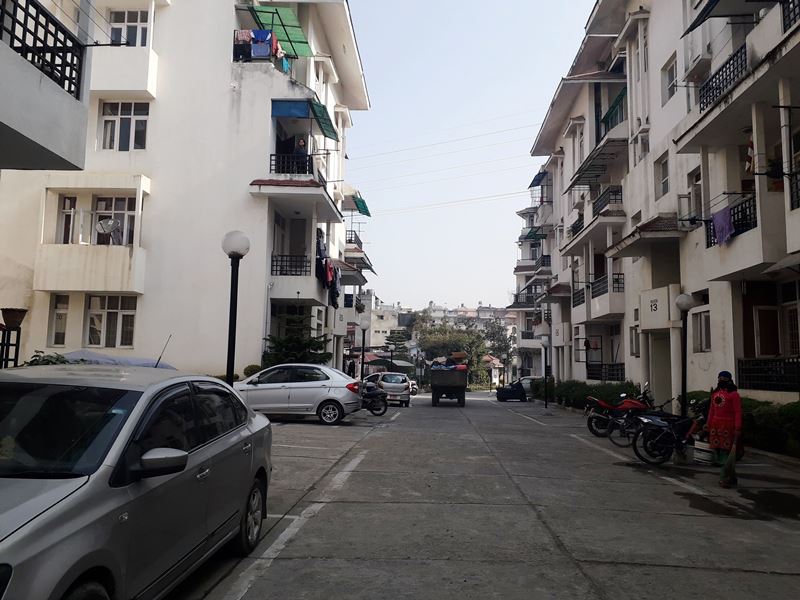
Kathmandu Residency Apartment, Bagdol Laltipur.
After two years of waiting, Subodh Pyakurel was excited to get the keys to his new flat at Kathmandu Residency Apartments, Bagdol, Lalitpur. He had invested Rs 1.2 million on the unit and was looking forward to a quiet and comfortable life with his family in his new home. But before handing him the keys to his house, the staff of Ansal Chaudhary Developers Pvt Ltd. presented him with new documents. The human rights activist was shocked to find that the company was charging an additional fee of Rs 160,000 (Rs 80,000 for ‘external development’, Rs 50,000 for undisclosed purposes, and Rs 30,000 for membership in the homebuyers’ society). All these charges were in addition to the price he had signed for when he was booking his unit. What’s more, there was Rs 100,000 to be paid for parking.
Pyakurel was one of 130 clients who bought flats from the company owned by Chaudhary Group (CG), one of Nepal’s largest business conglomerates. (Initially, Ansal Chaudhary Developers was a joint venture of Indian company Ansal Buildwell Ltd. and CG Developers Pvt. Ltd. But CG bought out all the shares of the Indian company in 2009.) CG’s owner is Binod Chaudhary, a lawmaker representing the Nepali Congress–currently the largest opposition in Nepal. Chaudhary is also Nepal’s only billionaire on the Forbes List.
As Pyakurel started living in the complex, he found that there were other issues with his house. The residents of Kathmandu Residency wanted these types of issues rectified, but in attempting to seek recourse, they only found themselves mired in a legal battle with the developer that dragged on for a decade. The Supreme Court finally ruled in the residents’ favour in 2016. But that ruling, demanding that the developer return all additional fees taken arbitrarily, hasn’t been implemented yet.
“As of January 2019, the company owed around Rs 40 million, inclusive of interest, to the buyers,” says Bir Bhadra Shah, a former chairman of Kathmandu Residency’s residents’ committee.
“These big business houses regard us as their subjects,” says Pyakurel, still angry after so many years. “For them, the court ruling is just a piece of paper. Even the regulators are not keen on keeping a tight rein on the sector.”
Pyakurel’s predicament is similar to those suffered by many other Nepalis. Over the last two decades, many middle- and upper-middle-class Nepalis have dreamed of living in gated complexes. For most, the gated lifestyle is alluring because it promises membership in a community of similarly well-heeled neighbours, amenities aplenty, and protection from thefts and break-ins. For quite a few, buying a unit in these complexes makes for an investment whose value should continue to soar.
But for many such homebuyers, life inside gated communities has been nothing short of a never-ending nightmare. Because the sector is not governed by tight regulations and laws, developers have been able to exploit existing loopholes to not only not come through on contractual deliverables but to also slap on newer fees the home owners hadn’t signed up for. In many cases, the developers seem to be running a scheme of sorts, wherein they are mostly focused on newer projects they can start with the capital they generate from their existing, oftentimes uncompleted, projects. Meaning, the homeowners often end up living in shoddily built houses with a host of utility problems, inside a housing complex with problems around claims on common properties. They can’t turn to the regulatory bodies or the law to seek remedies: for the bodies are either toothless or don’t want to hold the developers accountable; and as for the laws that are supposed to govern the sector, there aren’t any to speak of that actually look out for homebuyers.
Breach of promises
Not surprisingly, the sector is rife with all manner of problems. Residents are battling issues ranging from a lack of access to drinking water and lack of proper sewage management to developers’ encroaching on their enclaves’ open spaces and parks. The list goes on. Many residents feel their houses are not structurally sound, and the overall quality of construction leaves a lot to be desired. In sum, the companies have failed to provide services as per contract agreements. Developers have held onto the titles of the housing projects’ common properties (roads, community buildings, drinking-water facility, etc) for years, without handing them over to a society of homebuyers. In some cases, developers have misused the property as collateral to get credit from banks.
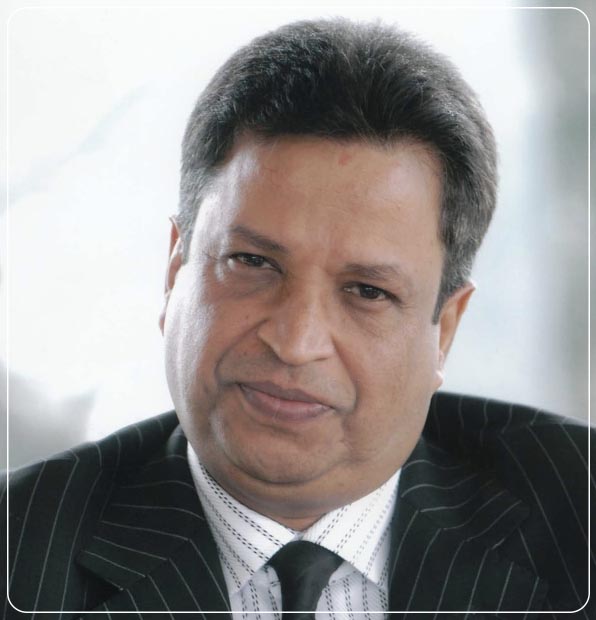
Binod Chaudhary Chairman of CG Group and MP Nepal’s only billionaire on the Forbes List. CGNews, Corporate Newsletter of Chaudhary Group, May 16-31, 2014
All these practices contravene the directives prescribed in the section for high-rises and gated communities in the National Urban Development Strategy of 2017. But the colony and high-rise apartment sector has been so entrenched in irregularities over the past two decades that the developers routinely get away with exceedingly shady practices.
Because they are backed by powerful officials, the developers simply continue to disobey directives. For example, after the Department of Urban Development and Building Construction (DUDBC) ordered Ansal Chaudhary Developers to refund all additional fees except those mentioned in their agreement, the company challenged the directive at the Appellate Court (now High Court) of Patan. This forced the home buyers to seek justice from the Supreme Court. On August 16, 2016, the apex court ordered the developer not to charge the buyers arbitrarily. But the ruling to refund the additional charges has not been implemented yet.
The majority of homebuyers in Kathmandu’s gated complexes have started to become wary of their developers. The earlier housing projects–for example, those built by Civil Homes Pvt Ltd, promoted by former MP Ichchha Raj Tamang, and by Comfort Housing Pvt Ltd (owned by Narendra Bajracharya and Rajesh Shrestha)–weren’t known for having many issues. But today even Civil Homes is yet to formally hand over the common properties to homebuyers in one of their projects in Bhaisepati, according to Prayas Paudel, Chairman of the Buyers’ Committee of the Bhaisepati project. Comfort Housing Pvt Ltd had promised buyers in their Thaiba housing complex that they would have their units ready between 15 to 24 months. But it took another three years for them to hand them over. The company blamed the blockade and the earthquakes of 2015 for the delay, says Narayan Shrestha, the vice president of the homebuyers’ society. “The company is yet to construct the promised park and swimming pool, and they have yet to add the finishing touches on several buildings,” he says.
Homebuyers at Dhobighat’s Sunrise Towers, built by Sunrise Developers Pvt Ltd, and promoted by Sumit Kumar Agrawal, say they too feel cheated by the developer. For one, they have had to pay for parking spaces separately. And the company has still not handed over the common properties to the community, even six years after the complex was constructed.
“We received a yellow sticker after the 2015 earthquakes, and even though we repaired the structure ourselves, we couldn’t get the green sticker because the developer didn’t cooperate,” says Dr Yadav Bishta, President of the Sunrise Towers Welfare Society. According to Bishta, Agrawal—who has been incommunicado for years—has yet to refund the membership fees to society members, and has failed to clear the electricity bills, for which money was collected from the members. Agrawal acknowledges that he had charged separate fees for parking, as external development costs, and that he still owns the common properties, including the road. “I could not hand over the road owing to the government’s unclear policy on the matter,” says Agrawal. He claims he has handed over the apartments to the community and denies collecting membership fees. He says the electricity bills accrued owing to billing errors on the part of the Nepal Electricity Authority.
Tamang, who seemed to be more scrupulous with his first project, has reached a low point with his ninth, in Godavari: now, he too is being accused of ‘cheating’ his clients. But Tamang has not yet been prosecuted because he enjoys political patronage.
“Government agencies are helping him instead of taking action against him,” says Dhruba Sharma, a resident of the Civil Homes complex in Kalanki.
Around 4km south of Satdobato, Lalitpur, lies idyllic Sunakothi. Amidst that setting sits Civil Homes’ third housing project, which features rows of identical houses with red roofs. The residents of this seemingly charming complex, however, are far from living a worry-free existence.
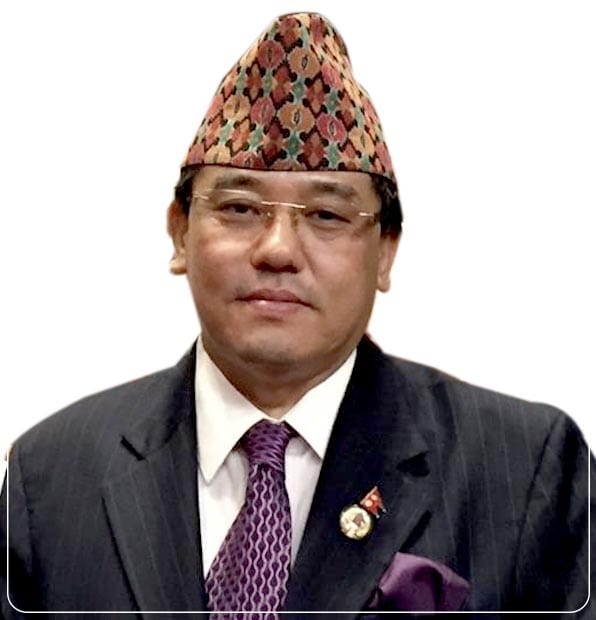
Ichchha Raj Tamang, Former MP. Photo source: Facebook
“The builder owns the road inside the complex to our house,” says Damodar Adhikari, a retired government official. Some 194 families are now involved in a legal battle over the road.
On August 8, 2018, 14 years after buyers moved into their new homes in one of his projects in Sunakothi (he has two projects there), Tamang took out a loan of Rs 91.6 million from National Cooperative Bank Limited, against a collateral comprising common properties from his complex, such as the road, community house, children’s playground, drinking-water plant, etc.
“It seems we have lost the road because of the loan taken out by Tamang,” says Jaydev Baidya, president of the Civil Homes Residential Society. “If he doesn’t repay the loan, the bank will seize the road,” says Adhikari.
A writ filed at the Supreme Court by the society in July 2019 seeks to confiscate the properties, including the roads and community park (whose ownership is still held by Civil Homes and the developer’s Civil Cooperatives) and transfer the properties to the homebuyers.
The victims say developer Tamang colluded with officials at the Kathmandu Valley Development Authority (KVDA) to amend the project’s particulars and borrow money from the cooperative.
“While approving the plan, instead of assigning ownership of the road to the residents, the Chief Commissioner of the KVDA, Bhaikaji Tiwari, amended the design under the influence of the company,” says Adhikari.
Tiwari, however, denies blame. “The amendment has not affected anyone,” he says. “And I don’t know about the loan taken out against the road.”
Stories abound about developers delivering shoddy buildings. For example, at Ansal Chaudhary Developers’ Hattiban’s Mount View Residency, in Lalitpur, around three dozen homebuyers discovered that their bathrooms were leaking. Eventually, the developer had to demolish and rebuild all the bathrooms, whose problems resulted from a lack of supervision during construction.
But there were other problems too. The developer had reclassified the complex as a ‘first phase’ project and expanded and added over 88 houses. The additions mean more people now have to share the extant water supply and open spaces. Further, according to homebuyers, the developer has not provided all the services that were advertised in the marketing brochure.
A ruling by the Lalitpur District Court on a case filed by three of the complex’s disgruntled homebuyers says that the additional homes had also made the roads narrower. The ruling, which was upheld by the Appellate Court, says: “It didn’t have stairs according to the design and the flooring was not carpeted with ceramic tiles.”
The builder also paid Rs 100,000 in fines to each of the three complainants, including cartoonist Rajesh KC, as directed by the court. Others in the complex, however, weren’t compensated because they did not go to court. “The housing brochure boasted European-style houses, but we realized later that their quality was very poor. That’s why we sought legal help,” says KC.
Even before the second phase was completed, the developer had amended the project design without taking the residents’ consent and opened up bookings for two colossal apartment towers, which were to be erected in the midst of the two-storied individual houses. An advertisement for the new units was featured right in the complex premises.
Chaudhary Group later backed down from constructing the towers only after strong protests from the homebuyers, according to Ramesh Maskey, a homebuyer in Mount View residency. These incidents show how easily developers can change a housing project’s designs for their own benefit.
CG declined to provide us explanations immediately. But Madhu Poudyal, Chaudhary Group’s general manager of Corporate Communication/Public Relation, did confirm that he had received our questions for this story. “I discussed the matter with the department head of real estate affairs, but we are unable to respond immediately during the lockdown, as we need to look into the documents of each housing project and consult with lawyers before responding to your questions,” he conveyed to us.
Deceitful marketing
Developers can play fast and loose with the rules because the seeds for the problems are sown from the outset–during the initial phase when a housing project is approved and monitoring of it is supposed to start. The project designs are approved by the KVDA and its units in the districts. Once developers get the approval, they usually place advertisements on hoarding boards. Most ads showcase exceedingly attractive complexes, and include a call out for bookings. They print glossy brochures, and start collecting money from homebuyers, who settle the payment even before the project’s construction is completed.
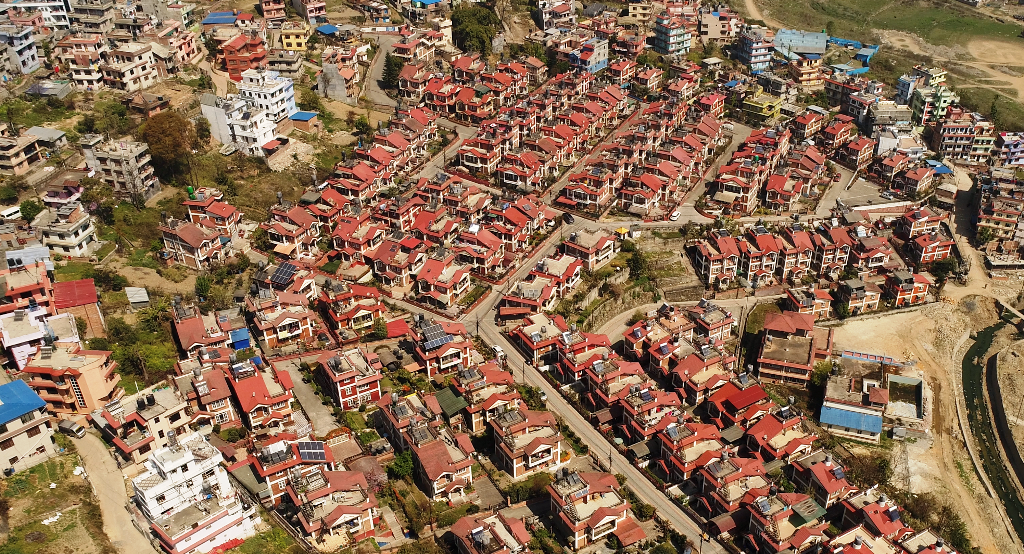
Civil Homes’ second housing project, in Tinthana, Kalanki, has 123 houses. The project was approved for only 96 houses on 65 ropani of land. But additional houses have been built in the open spaces. Rudra Pangeni
The developers use only a portion of that money to build the houses and apartments advertised in the marketing campaigns. They invest large chunks of the advance and bank loans on buying plots for newer housing sites. To obtain the loans, they put up as collateral the property they are developing. And thus begins the next booking cycle.
The developers usually promise they will complete a house or flat in two years, but none of the projects we investigated were completed on time. Most overshot their deadline by at least two or three years. But because the homebuyers were afraid they would lose their investment, they mostly remained silent.
The mechanisms and protocols meant to govern the sector are oftentimes extremely murky and more often than not overlooked. The KVDA is supposed to approve a housing project under the condition that its units cannot be sold before the project’s units are completed. But according to Bhesh Raj Lohani, General Secretary of the Nepal Land and Housing Developers’ Association, the developers are not aware of the KVDA provision that the units can be sold only after they get a completion certificate.
“The industry must be regulated, and policy issues such as those pertaining to transfers (of ownership) of common properties in the projects must be resolved, as there is an issue of who should pay the taxes for the transfer,” says Lohani.
Sometimes developers even tweak a project design on whim, by, for example, moving open spaces and parks to a different location. They tamper with the project to bring in more homebuyers. Mostly the units for these additional clients eat away at the open spaces and make the roads narrower and the parks smaller. Changing designs is illegal, but developers collude with KVDA officials to get their way.
The incident at Mount View Residence, mentioned earlier, is a case in point. But most buyers don’t even know that developers routinely tamper with project designs.
A similar problem occurred at Civil Homes’ ‘4th Phase’ housing project in Dhapakhel, Lalitpur. The developer had received planning permits for two apartment complexes (including one that is still incomplete) and two separate individual housing projects. But two public roads pass through the area, which has raised the issue of safety for the communities. Furthermore, only one borehole supplies drinking water to all three projects, which house about 250 families. But the water is not sufficient, nor is it potable, although the Civil Homes’ website tells visitors that the facility has running water from a modern water-treatment plant.
Purna Maharjan, an information officer at the District Commissioner’s Office (KVDA unit) of Lalitpur, acknowledged the problem with the drinking water at the Dhapakhel project. But the matter has not been resolved yet.
“The water is not treated, and we don’t get enough, anyway. Untreated sewage flows into the water source. But the authorities do not care,” says Shailesh Sharma, a member of the Civil Homes Residential Society in Dhapakhel. Tamang, the chairman of Civil Homes Pvt Ltd, and director Keshav Lal Shrestha did not respond to repeated calls and text messages seeking their comments for this article.
Developers hand in glove with regulators
Civil Homes’ second housing project, in Tinthana, Kalanki, has 123 houses. The project was initially approved for only 96 houses on 65 ropani of land. But additional houses have been built in the project’s open spaces. Two years ago, the KVDA informed the homebuyers’ community that the designs for 27 additional houses had not been approved. But the KVDA did not do the needful to stop the developers. That act of negligence was far from a first.
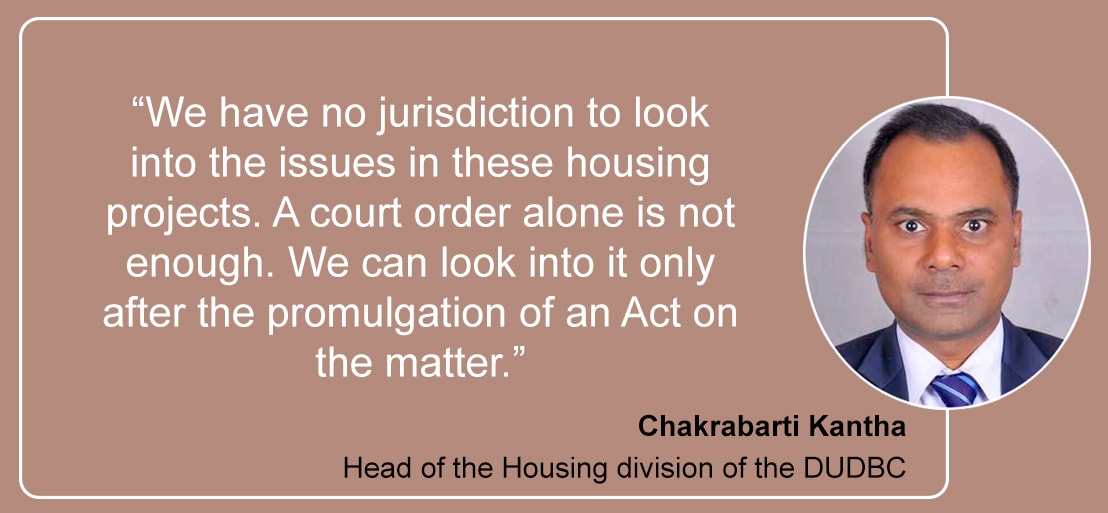 In 2010, the KVDA had written a letter to Civil Homes regarding their non-compliance, as the company had built more houses than had been approved, according to documents provided to CIJ. But action on that matter hasn’t been taken yet. That no action has been taken despite the letter shows that Tamang was hand-in-glove with KVDA officials, according to resident Dhruba Sharma.
In 2010, the KVDA had written a letter to Civil Homes regarding their non-compliance, as the company had built more houses than had been approved, according to documents provided to CIJ. But action on that matter hasn’t been taken yet. That no action has been taken despite the letter shows that Tamang was hand-in-glove with KVDA officials, according to resident Dhruba Sharma.
Later, Tamang borrowed Rs 40 million from National Cooperative Bank Limited by putting up the Kalanki complex’s common road and community building as collateral.
The DUDBC, another regulatory agency, which is supposed to vet designs of buildings and project implementation, didn’t take action against the company, either. On April 13, 2010, the residents of Civil Homes, Kalanki, visited the DUDBC to file a complaint against Tamang. The complaint listed two dozen issues, including the misleading of the home buyers and violations of building standards. Each house had been built with 224 square feet less area than had been mandated in the agreement. The 12-page complaint sought Rs 214.7 million in compensation from the company. It also demanded that the company’s license be revoked.
After the DUDBC refused to accept the complaint, the residents filed a writ petition in Patan’s Appellate Court. The court directed the DUDBC to accept the complaint. Tamang then moved the Supreme Court, demanding that the Kathmandu Valley Development Authority look into the matter. The Supreme Court dismissed Tamang’s petition on 23 October, 2016.
“But since then, the department has not addressed our complaint. We have also complained to the Commission for the Investigation of Abuse of Authority,” says Dhruba Sharma, former general secretary of the complex’s Residential Society.
But the DUDBC says it can’t resolve the problems. “We have no jurisdiction to look into the issues in these housing projects,” says Chakrabarti Kantha, head of the housing division of the DUDBC. “A court order alone is not enough. We can look into it only after the promulgation of an Act on the matter.”
Bhesh Raj Lohani, General Secretary of the Nepal Land and Housing Developers’ Association, says it is illegal for a developer to borrow money by putting up common properties, like roads, as collateral. “That is a dishonest act and constitutes fraud,” he says.
In the absence of proper oversight, the sector continues to operate unchecked. The Forum for the Protection of Consumer Rights Nepal says complaints from home buyers have increased over the years. “When it comes to price, the homebuyers keep getting ripped off. The buyers are promised health clubs, swimming pools, and so on, but the builders hold the ownership of the facilities, breaching the agreement. This sector is growing irresponsible every day,” says Jyoti Baniya, president of the forum.
Weak regulation
The rot in the sector starts right from the top. The Supreme Court has clearly identified the DUDBC as the regulator for monitoring the high-rise and colony segment. But three-and-a-half years on from that ruling, the DUDBC’s housing division has yet to establish a branch to look after the sector. It has been two decades since companies started building and selling houses in complexes, but there is no separate law governing the sector. The Joint Housing Act 1997, which includes only apartments (the DUDBC looks after this sector), is also outdated. There is no new Act in the offing.
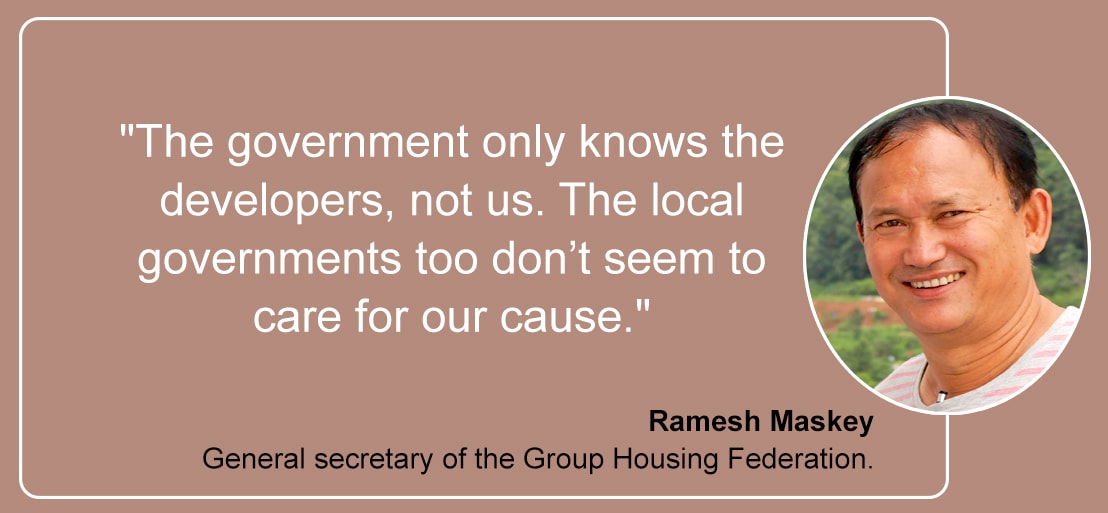 Exploiting such weaknesses in the regulations, some apartment builders have completed projects without even obtaining the go-ahead to do so. About 100 families have been living in Mero City Apartments in Hattiban, Lalitpur, since May last year, but according to information provided to CIJ on March 18, 2020, the high-rise does not figure in the list of apartments whose designs have been approved by the DUDBC. And according to Lalitpur Metropolitan City and the DUDBC, Royal Orchid Developers Pvt Ltd (promoted by Nirmal Agrawal and Ganesh Agrawal), who built the apartments, applied for approval only after almost completing the project a few months ago.
Exploiting such weaknesses in the regulations, some apartment builders have completed projects without even obtaining the go-ahead to do so. About 100 families have been living in Mero City Apartments in Hattiban, Lalitpur, since May last year, but according to information provided to CIJ on March 18, 2020, the high-rise does not figure in the list of apartments whose designs have been approved by the DUDBC. And according to Lalitpur Metropolitan City and the DUDBC, Royal Orchid Developers Pvt Ltd (promoted by Nirmal Agrawal and Ganesh Agrawal), who built the apartments, applied for approval only after almost completing the project a few months ago.
As of today, the DUDBC has not approved the design yet, and the safety of the building remains questionable. The CEO of the company, Subash Chaudhary, has acknowledged that they have yet to get the design approval from the DUDBC. “We have our own design, and now we need design approval to get a completion certificate to transfer property titles to buyers,” says Chaudhary.
Engineers say getting an approval constitutes just the first part of the process.”An approval for the design isn’t enough,” says Rajan Suwal, a structural engineer. “Authorities should check whether the buildings are safe for accommodation and allow in residents only after they get a completion certificate.” And yet, on March 2, 2020, Orchid Developers published an advertisement on the front page of Republica daily. “Only a few flats remaining,” it read.
The DUDBC seems to not want to answer for these lapses.”Customers themselves should be aware of such issues before buying flats,” says Chakrabarti Kantha, the head of the housing division at the DUDBC.
But Suwal begs to differ. “The issue has reached this point because those close to power centres take the design for granted because it is simply a piece of paper,” he says.
The DUDBC itself has been hobbled by its own problems. It faces shortages of human resources. Its housing division remained without a leader for almost a year, until in early February 2020, when Kantha finally became the head of the division. In mid-February, senior Divisional Engineer Rama Manandhar was appointed as the head of the housing branch under the division. Manandhar doesn’t have prior experience in the branch. The division has one superintendent engineer, one senior divisional engineer, three engineers, and a sub-engineer. Only two of them work full-time. The others are required to work for other divisions too.
A mishmash of mechanisms
All these problems probably would not have transpired if the high-rise and housing-colony sector operated in accordance with stringent rules. Or if the overall mechanism governing the sector had been tweaked to meet the need of the times. Or if the authorities strictly enforced the existing rules. As of today, the sector suffers from problems pertaining to the rules themselves and problems arising from lack of oversight. And because of this state of affairs, the developers have become so emboldened, they can do as they please, say housing experts.
What measures would help?
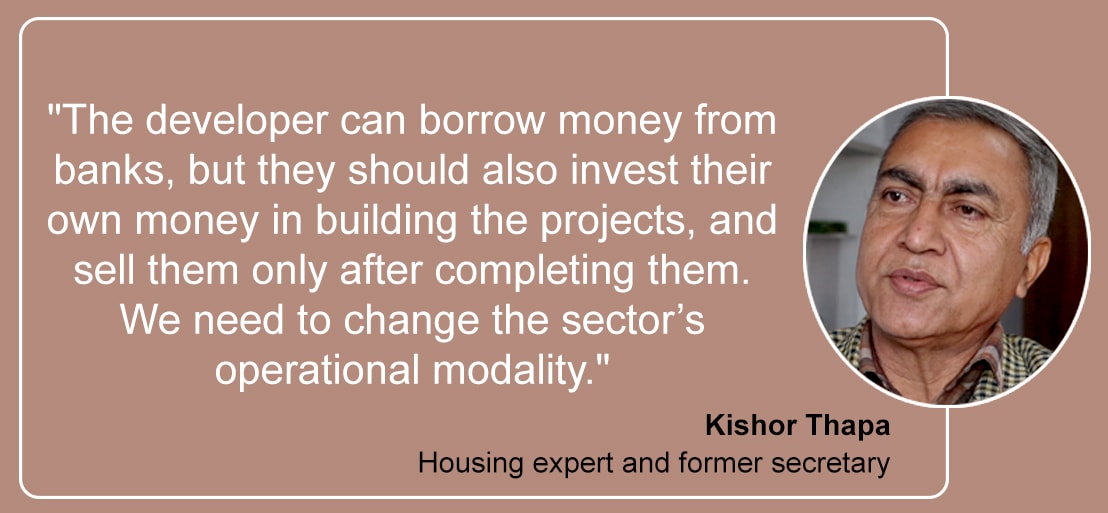 “The developer can borrow money from banks, but they should also invest their own money in building the projects, and sell them only after completing them. We need to change the sector’s operational modality,” says former Secretary and housing expert Kishor Thapa.
“The developer can borrow money from banks, but they should also invest their own money in building the projects, and sell them only after completing them. We need to change the sector’s operational modality,” says former Secretary and housing expert Kishor Thapa.
Enacting and implementing such rules would be a start. But the unhealthy nexus between developers and authorities too needs to be eliminated. Authorities often favour builders, and homebuyers are voiceless. While the Nepal Land and Housing Developers’ Association is represented in the Apartment Monitoring Committee under the Joint Housing Construction Approval and Monitoring Procedure 2013, homebuyers are not represented. The committee is responsible for dealing with issues in the housing sector, particularly those pertaining to apartment projects.
“It’s unconscionable that homebuyers are not represented in such a committee. The Minister of Urban Development should immediately amend the procedure and ensure their representation,” says Purna Kadaria, former secretary.
“The government only knows the developers, not us,” says Maskey, who is also general secretary of the Group Housing Federation, a network of homebuyers. “The local governments too don’t seem to care for our cause,” he says. And even though residents in these housing projects pay comparatively higher taxes for design approval and property taxes, local governments do not allocate a single rupee for the sector, he complains.
Shishir Baidya, a journalist who lives in the Comfort Housing complex in Thaiba, Lalitpur, recently wrote an article in Nepal Weekly, titled ‘Housing Trouble’. “The problems we face are legion,” he wrote. “Sometimes we have no running water. There are frequent power outages. Sometimes the sewage doesn’t work. Water leakages resulting from the use of poor material are common. Sometimes, the pipes burst.” He wrote: “Neither the regulatory body nor the local body has paid any attention to these things.”
But to root out the problems, the government must first get to their root.
“The government should enact new laws to address the problems facing the buyers,” says former Secretary Thapa.



